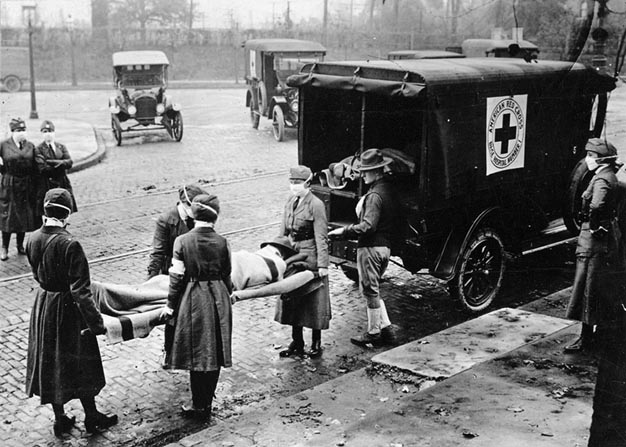
With masks over their faces, members of the American Red Cross remove a victim of the Spanish Flu from a house in St. Louis, Mo., in 1918.
By Timothy Walch
For The Catholic Messenger
In the fall of 1918, Iowa and the nation defeated one enemy and wrestled with another. On Nov. 11, Iowans welcomed an allied victory and the end of war in Europe. At the same time, the state and the nation struggled with a second enemy — an influenza pandemic. Before it was over, more than 93,000 Iowans had been infected and 6,000 had lost their lives.
The pages of The Catholic Messenger tell the story of how Iowa Catholics responded to this terrible and invisible threat. The editors began by explaining that the “Spanish influenza” was a misnomer. It wasn’t Spanish in origin, but a common virus. The paper urged calm and noted that pandemics had been cyclical in American life since 1647.
But diocesan officials were concerned about spreading the disease. As early as the middle of October, pastors closed schools and built altars on rectory porches so that Mass could be celebrated outdoors. Even St. Ambrose College in Davenport closed its buildings and “compelled students to work out their education at home.”
Iowans struggled with the spread of the illness and many small towns were overwhelmed. By Oct. 24, for example, the Messenger reported that Catholics in western Iowa not only closed parish schools, but also turned the buildings over to public health officials for use as temporary hospitals. There were more than 1,000 cases in the southwest quadrant of the state.
Closer to home, the Sisters of Humility in Parnell shifted their commitment from teaching at the parish school “to serve at the bedside of the stricken members of the community.” That the community was grateful for this compassion was without question. The nuns were, by terms we use today, “first responders.”
The response to the crisis was led by both church and state. Public health officials called for residents to quarantine themselves at home and to wear masks and maintain social distancing if they had to travel. For their part, diocesan and parish officials endorsed all state admonitions until the worst had past.
But even these measures were not enough to mitigate personal tragedy. The Messenger reported the terrible loss of loved ones including priests and women religious who had ministered to the sick and then were infected with the flu themselves. Typical were stories with headlines such as “A Bright Young Life is Ended” and “A Young Mother Answers Summons.”
By the third week of November, the paper cried out in grief: “Has not the cruel epidemic stolen away our loved ones by the thousands?” wrote the editors. “Is there any community that has not felt its lash? How many homes wrapped in sorrow? How many hearts bound in grief?”
The Dec. 5 issue summarized the ordeal of the previous two months: “Overcrowded hospitals and long columns of death notices in the daily newspapers show Davenport suffering from the worst epidemic with which the city was ever afflicted.”
The editors were not exaggerating. The situation was just as bad all across the state and the nation and around the world. Before it was over in the early weeks of 1919, more than 675,000 Americans had died of the flu, a small portion of the 50 million who had died worldwide.
Yet throughout the dark weeks of November and early December, Iowa Catholics never lost hope in the mercy of God. As the state and the country moved closer to Christmas, the number of cases and deaths seemed to abate.
The Messenger urged caution and diocesan officials agreed. Christmas Masses would be brief with no special services. “All are warned to exercise the same care as formerly,” added the editors, “as the danger of spreading the illness remains the same.”
On Dec. 26, the Messenger reported that the epidemic “had practically disappeared from Davenport” with a substantial decline in the number of new cases. It was a Christmas miracle! Over the next few weeks, Iowa Catholics would return to worship and other social activities.
The Great Influenza Pandemic of 1918 was largely forgotten until COVID-19 reminded us that we are still vulnerable to a public health crisis. Today we have many more tools to fight a virus, but we also need to remember that hope and prayer remain powerful tonics in this contest.
We will endure through this epidemic just as our ancestors did a century ago. And just as the Messenger documented the ordeal in 1918, it is doing the same today. Stay Iowa Catholic strong!
(Timothy Walch is a lay director of St. Thomas More Parish in Coralville and a member of the Board of Directors of The Catholic Messenger.)











